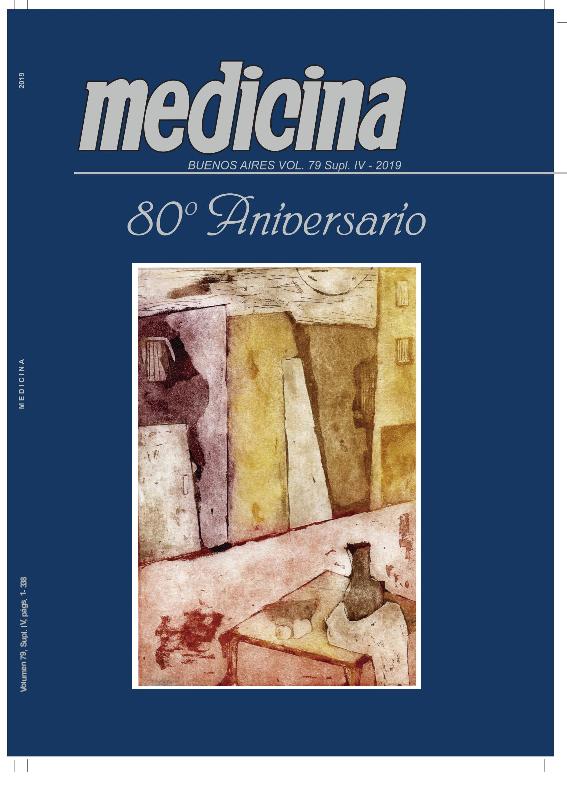Mostrar el registro sencillo del ítem
dc.contributor.author
Solana, María Victoria

dc.contributor.author
Scarcella, Silvana Andrea

dc.contributor.author
Solana, Hugo Daniel

dc.date.available
2022-09-16T16:05:31Z
dc.date.issued
2019
dc.identifier.citation
Finding of Fasciola hepatica in a capybara (hydrochaeris hydrochaeris) in Tandil, province of Buenos Aires, Argentina; LXIV Reunión Anual de la Sociedad Argentina de Investigación Clínica; LI Reunión Anual de la Asociación Argentina de Farmacología Experimental; XXI Reunión Anual de la Sociedad Argentina de Biología; XXXI Reunión Anual de la Sociedad Argentina de Protozoología; IX Reunión Anual de la Asociación Argentina de Nanomedicinas y VI Reunión Científica Regional de la Asociación Argentina de Ciencia y Tecnología de Anima; Mar del PLata; Argentina; 2019; 230-230
dc.identifier.issn
0025-7680
dc.identifier.uri
http://hdl.handle.net/11336/169121
dc.description.abstract
Fasciolosis is a zoonotic parasitic disease caused by Fasciola hepatica . The life cycle of thisparasite is indirect, it needs a snail of the Lymnaea family as an intermediate host to complete the cycle and sothe occurrence of cases is limited to the presence of these snails. Most of thestudies of this parasitic disease are in domestic animals and humans. Greateconomic losses are generated by this disease. Wild species are known to act asreservoirs and disseminators of the disease. The south-eastern zone of the province of Buenos Aires has been described with reference to the presence of Fasciola spp. in cattle but it is not yet known whether wild herbivores living in the zone are involved in the biological cycle of this disease. Among the wild species that have been positively reported to Fasciola hepatica the capybara, Hydrochaeris hydrochaeris is a poorly described species. In August of the present year, in the district of Tandil(BsAs), a dead capybara recently run over was found. At the macroscopic inspection the liver was apparently normal. At the magnifying glass inspection of the gall bladder, characteristics yellowish eggs were found. They were photographed with the Leica microscope and it can be seen that due to their morphology, size and location they were compatible with >Fasciola hepatica eggs. PCR was performed in search of the mitochondrial gene ITS1 (species indicator) confirming that the eggs found in the capybara belonged to Fasciola hepatica This is attractive for two main reasons; first, in the area where the animal was found there are no scientific reports of this disease or the presence of the snail, which prompts us to work on a more exhaustive search for cases. And secondly, the study of wild species as transmitters of this disease is not well studied and this ends up being a complication for producers and for the population ingeneral, so we consider that its study is very important.
dc.format
application/pdf
dc.language.iso
eng
dc.publisher
Fundación Revista Medicina
dc.rights
info:eu-repo/semantics/openAccess
dc.rights.uri
https://creativecommons.org/licenses/by-nc-sa/2.5/ar/
dc.subject
FASCIOLA
dc.subject
CAPYBARA
dc.subject
TANDIL
dc.subject.classification
Ciencias Veterinarias

dc.subject.classification
Ciencias Veterinarias

dc.subject.classification
CIENCIAS AGRÍCOLAS

dc.title
Finding of Fasciola hepatica in a capybara (hydrochaeris hydrochaeris) in Tandil, province of Buenos Aires, Argentina
dc.type
info:eu-repo/semantics/publishedVersion
dc.type
info:eu-repo/semantics/conferenceObject
dc.type
info:ar-repo/semantics/documento de conferencia
dc.date.updated
2022-08-30T18:13:43Z
dc.journal.volume
79
dc.journal.number
4
dc.journal.pagination
230-230
dc.journal.pais
Argentina

dc.journal.ciudad
Ciudad Autónoma de Buenos Aires
dc.description.fil
Fil: Solana, María Victoria. Consejo Nacional de Investigaciones Científicas y Técnicas. Centro Científico Tecnológico Conicet - Tandil. Centro de Investigación Veterinaria de Tandil. Universidad Nacional del Centro de la Provincia de Buenos Aires. Centro de Investigación Veterinaria de Tandil. Provincia de Buenos Aires. Gobernación. Comision de Investigaciones Científicas. Centro de Investigación Veterinaria de Tandil; Argentina
dc.description.fil
Fil: Scarcella, Silvana Andrea. Consejo Nacional de Investigaciones Científicas y Técnicas. Centro Científico Tecnológico Conicet - Tandil. Centro de Investigación Veterinaria de Tandil. Universidad Nacional del Centro de la Provincia de Buenos Aires. Centro de Investigación Veterinaria de Tandil. Provincia de Buenos Aires. Gobernación. Comision de Investigaciones Científicas. Centro de Investigación Veterinaria de Tandil; Argentina
dc.description.fil
Fil: Solana, Hugo Daniel. Consejo Nacional de Investigaciones Científicas y Técnicas. Centro Científico Tecnológico Conicet - Tandil. Centro de Investigación Veterinaria de Tandil. Universidad Nacional del Centro de la Provincia de Buenos Aires. Centro de Investigación Veterinaria de Tandil. Provincia de Buenos Aires. Gobernación. Comision de Investigaciones Científicas. Centro de Investigación Veterinaria de Tandil; Argentina
dc.relation.alternativeid
info:eu-repo/semantics/altIdentifier/url/https://www.medicinabuenosaires.com
dc.relation.alternativeid
info:eu-repo/semantics/altIdentifier/url/https://www.saic.org.ar/reunion-anual
dc.conicet.rol
Autor

dc.conicet.rol
Autor

dc.conicet.rol
Autor

dc.coverage
Nacional
dc.type.subtype
Reunión
dc.description.nombreEvento
LXIV Reunión Anual de la Sociedad Argentina de Investigación Clínica; LI Reunión Anual de la Asociación Argentina de Farmacología Experimental; XXI Reunión Anual de la Sociedad Argentina de Biología; XXXI Reunión Anual de la Sociedad Argentina de Protozoología; IX Reunión Anual de la Asociación Argentina de Nanomedicinas y VI Reunión Científica Regional de la Asociación Argentina de Ciencia y Tecnología de Anima
dc.date.evento
2019-11-13
dc.description.ciudadEvento
Mar del PLata
dc.description.paisEvento
Argentina

dc.type.publicacion
Journal
dc.description.institucionOrganizadora
Sociedad Argentina de Investigación Clínica
dc.description.institucionOrganizadora
Asociación Argentina de Farmacología Experimental
dc.description.institucionOrganizadora
Sociedad Argentina de Biología
dc.description.institucionOrganizadora
Sociedad Argentina de Protozoología
dc.description.institucionOrganizadora
Asociación Argentina de Nanomedicinas
dc.description.institucionOrganizadora
Asociación Argentina de Ciencia y Tecnología de Animales de Laboratorio
dc.source.revista
Medicina (Buenos Aires)

dc.date.eventoHasta
2019-11-16
dc.type
Reunión
Archivos asociados
